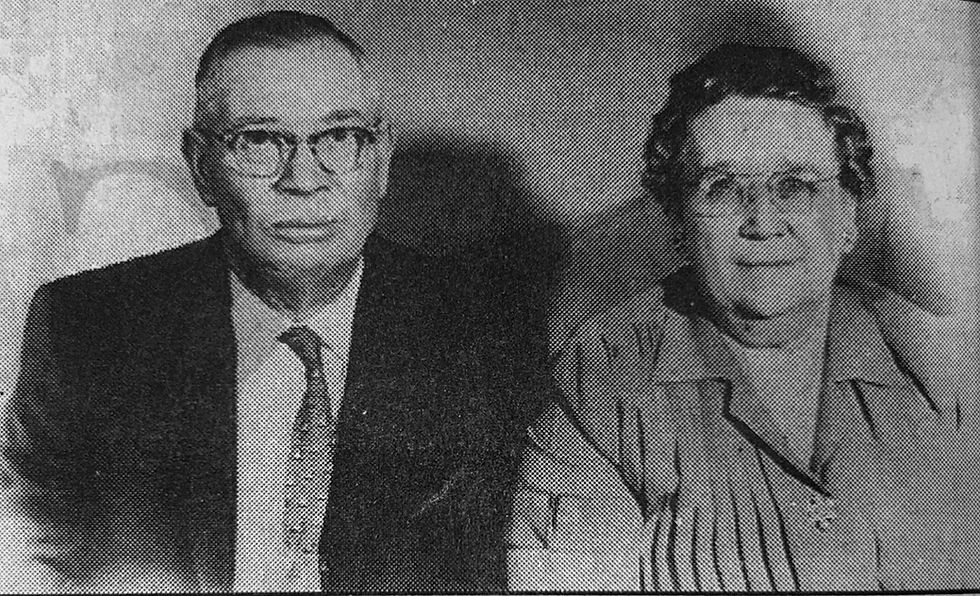Recollections: Legends of Yesterday - Casey Jones & His Famous Engine
- gvnews7
- Jun 3, 2024
- 4 min read
This is a reprint of original articles by Hugh Woolley, a longtime resident and community leader of Graceville. Woolley published these articles in The Graceville News more than 20 years ago.
Originally published in the May 24, 2001 edition of The Graceville News.
I recently became interested in the railroad that came to Graceville in 1902. C.P. Cassidy was the engineer that drove the first steam locomotive through Graceville in 1902. You will hear more about him later.
Joe Bill Hodges and I agreed to give a program for the Historical Society on the early railroads. George Stephenson (1781-1848), an Englishman credited with the first steam locomotive that ran on rails. Let's note here that the first railways were powered by animal power. Stephenson, an engineer 1822, persuaded the directors to use steam instead of animal traction on the Stockton and Darlington railway. "Rail Mania" took over throughout most of the civilized world. It climaxed about 1844. Stephenson, along with his only son. Robert, and also nephew, George Robert, contributed much to the railways of the world.
It is amazing what God can do with the mind of man and the talents that have brought about the scientific changes just in my lifetime. It would be hard to date the beginning and the end of the great industrial revolution. Some scholars place the beginning during the Medieval period. If I had to pick a period of 100 years, I would pick 1750 to 1850. However, some great inventions occurred before then. For example, John Kay's flying shuttle in the textile industry was in 1733.
Manufactured goods in large quantities demanded better and faster ways of transportation. The most important transportation development during the Industrial Revolution was steam locomotion. Therefore, the inventions of George Stephenson and Robert Fulton (an American) put steam locomotion on land and sea.
The steam engine in its self is one of the most fascinating mechanical inventions to me. I grew up in sawmill country. In my mind I can see one running at a standard speed with the governors slinging outward to keep it from running away. The giant piston pushing the big fly wheel around, creating the power that is to pull all the machinery for the mill or factory.
It is something else to mount a steam boiler and steam engine on rails to create a locomotive to pull a train. That is fascination at its maximum. It was for me as a boy and still is as an old man. You add the steam whistle to the mighty rumble and roar and it gets better and better. I believe Roy Acuff describes it as well as any in the song, "Wabash Cannonball.
I was raised on a two mule farm in Central Alabama. The Mobile and Ohio Railroad was about a quarter of a mile from our home and cut across our back forty. Those doubleheaders (2 steam locomotives) roaring past our house and through the swamp of the back forty would sound like a full grown tornado. We as kids would get under the trestle and brag about how a freight train had run over us.
We use to have a old Edison Victrola or phonograph.It was run by a spring. You would wind up with a crank to play a recorded song with a needle and disc. Some of the old songs were about brave railroad engineers who died with their locomotives. Namely "Wreck of Ole '97" and the famous Casey Jones. Other recordings I remember "Golden Slippers", I am a Rovin' Gambler", "Ole Dog Blue", "Hand Me Down My Walking Cane, "The Great Titanic", and of course the love ballad, "Barbara Allen".
In the year 1900 the gasoline automobile had been invented, but little development had occurred. I believe it was 1908 before Henry Ford (the man who put America on wheels) came out with his first Model T. The Wright Brothers had not yet made their historical flight at Kitty Hawk, NC. The steam locomotive had really advanced since the Civil War. Several big battles during the war were fought over railroad centers namely Shiloh (Corinith railway center in north Mississippi), and the great battle of Chickamauga (Chattanooga railway center). General Lee sent the largest troop movement by rail from Virginia that the world had ever seen. Longstreets muzzle loading veterans arrived the second day of the battle, broke the line and won the last big victory for the south. However, it was all in vain since General Bragg didn't know what to do with victory. The big battle was fought after the battles of Gettysburg and Vicksburg.
The railway system of the U.S. played a very important part in the movement of supplies to each side during war. According to Britannica,on the eve of the Civil War there were over 30,000 miles of track in the U.S. It was about four years after the war, May 10, 1869, that the Union Pacific met the Central Pacific and drove the golden spike in Utah uniting the east with the west. Railroad building flourished the following years. During the 1880's some 70,000 route miles were built. America was becoming the world's leading nation miles of railroad.
Getting back to 1900, Арril 29th of the year, Casey Jones made his famous ride. The time was ripe for a record run. The engineer on the cracked passenger train had suddenly became ill. This fast passenger train ran from Chicago to New Orleans on the Illinois Central railroad, better known as the Chicago Line. Anyway, the train was being made up Memphis and was short of an experienced engineer. Casey's regular run was from Memphis to Canton, Mississippi, about 190- mile run. Since Casey knew the track real well, he was asked if he would double back on the run that he had just made. Casey replied," I will if you will let me use my engine and have Sim Webb as my fireman. " So, Casey hooked up engine number 382 and pulled on to the main line. The train was 95 minutes late. There is little doubt about Casey being a genius. Some would classify him as a daredevil. He would fudge a little on the curves and when he hit a straight away he would pull the throttle open.

PHOTO CUTLINE: Casey Jones and his famous engine
To subscribe to The Graceville News visit Pricing Plans.





Comments